Peruvian ITiCSE
I had intended the summer to be a simple one. No teaching, no big grants, no painting the house. Then I learned that ITiCSE 2016 would be in Peru. This country is so far off the maps that chart out my life I knew that if didn’t go now, I never would. So, I submitted both a paper and a working group proposal in an attempt to double my chances at getting something accepted. The paper was rejected, but the working group made it in. So, I spent this past week gathering together with fellow computer science educators from exotic places like Illinois, Virginia, Ohio, Kentucky, California, Britain, Colombia, Spain, and China to talk about games for teaching our students about computer science.

Before the conference, we’d discovered and played around 120 games that facilitated the learning of computer science concepts. During the conference, we collectively analyzed what worked in these games and what did not through the lens of educational psychology, games studies, and computer science itself. We began writing a report of our survey and our plan to make some of our own games over this next year. By the end of the conference, we were at about 40 pages in Google Docs. Ultimately everything must squeeze into 25 pages. Wish us luck.
Some of my friends think it’s a little excessive that I’d go all the way to Peru to talk to other educators about education, but these sorts of trips impact me in a way that East Lansing and Atlanta do not. I come back having learned what parts of my life are artificially propped up by my culture. I spend a significant amount of time working side by side with my new colleagues, and our foreign environment binds us together as we walk strange streets, climb mountains, and try to figure out what the Spanish-speaking taxi driver just said. A working group is the absolute best way to experience a conference—it’s like getting a new family for a few days.
While the memories are fresh, I share here a few notes about my journey.
Thursday
I got a little concerned when I found a bug on my airplane. The seat directly in front of me had two identical stickers, whereas the one to its left had two different stickers! Either I didn’t have a life jacket, or the seat was mislabeled. Since we weren’t going to fly over water, I kept my mouth shut.
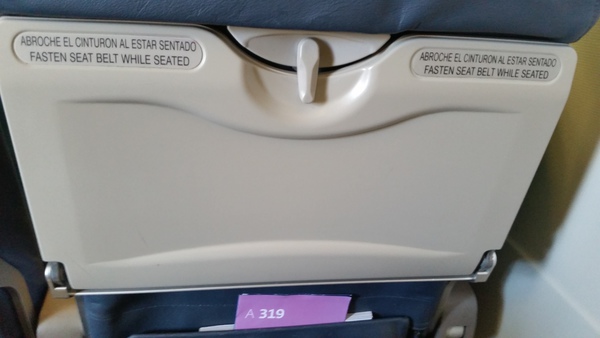
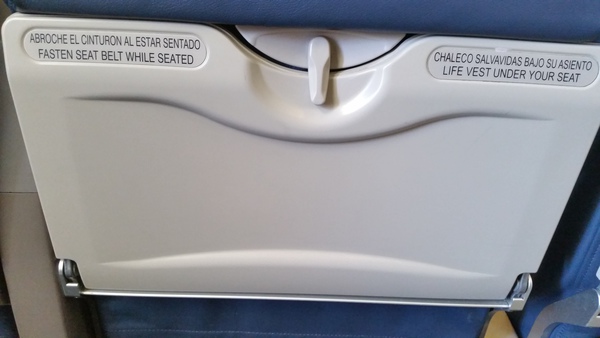
My flight left from Minneapolis, where all the airport televisions talked about was about FBI director Jim Comey not recommending charges be pressed against Hillary Clinton. Having worked with many system administrators in my life, I could wholeheartedly understand the desire to run one’s own server. But that’s not the kind of thing one can say to a stranger, so I kept my mouth shut. I made it to Dallas just in time to brush my teeth and board my connecting flight. As I lined up to disembark, I learned that some police officers in Dallas had been shot.
On the plane from Dallas to Lima, I sat behind the family of Chuck, a professor I know who teaches in Nebraska. Chuck had decided to make this trip double as a family reunion.
Friday
On Friday I flew from Lima to Arequipa, the city which was to be my home for a few days. Peru has volcanoes. The airport is right below a couple of dormant ones.
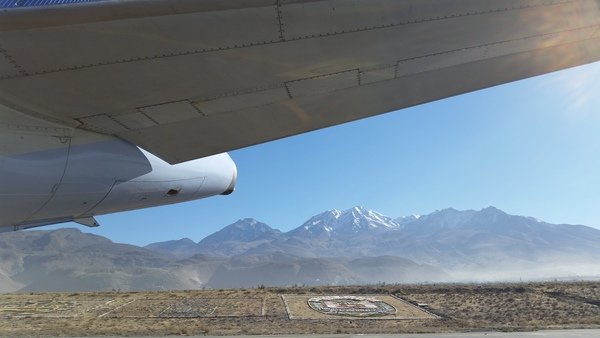
Chuck’s family let me bum a ride with them from the airport to their hotel. The taxi driver seemed to have a very serious concern about our arrangements, but we couldn’t figure out what question he was asking us. He tried to fall back on Italian, his first language, but we shrugged. Thankfully, he got us where we needed to be.
My hotel was just a few blocks farther on. I dropped off my bag and headed back to be part of Chuck’s family for the afternoon. At one of the intersections, some men jumped in front of the cars stopped at a red light and did some crazy acrobatics for the captive audience—presumably to make some money. At the hotel, we had lunch (burgers and fries!) and some much needed water (bottled!). Some of the family was from my home state of Iowa, and since Iowans bond easily, we bonded.
In the evening, our working group met for the first time, except for the member whose family’s flight had been delayed two whole days and the other member who had gotten to the airport only to find no luggage in his trunk.
As we walked from the university to a restaurant called Chicha, we saw a woman selling churros on the street. We thought we’d stop by her stand later in the week. Sadly, I never saw her again. Missing out on this churro is probably the biggest regret of my trip. At the restaurant, I ordered the lomo saltado. It was the second of many meat dishes I was to eat. There really isn’t much else to order.
Saturday
Having refreshed ourselves after our travels, our working group began its intense discussion and writing on Saturday. Each day we would walk from our hotels down the narrow sidewalks where two may not walk abreast and over the slightly dangerous La Avenida de Juan de la Torre to the university.

Peru has two seasons: rainy summer and dry winter. We were there in the dry winter, which meant 70 degree temperatures during the day.

One of the nice things about the dryness is that most buildings are designed around open air. You don’t have to open many doors, because there aren’t many! After leaving our hotel, the only door we had to open was the one to the classroom where we met for the day.

Nowhere in town can you escape the looming volcanos. One of them, deceptively named Misti, is expected to blow in about 100 years. The tour guide wasn’t clear on what that would do to the city, but she assured us that it would hold off for us.

Sunday
On my walk to the university, there was a learning center that offered to teach coding skills and mathematics. I felt compelled to enroll because I didn’t know what DFD and Pseint were. Apparently, DFD is short for data flow diagram, and PSeInt is a flow chart editor for composing programs. Unlike a great deal of software, PSeInt seems to exclusively target speakers of Spanish.
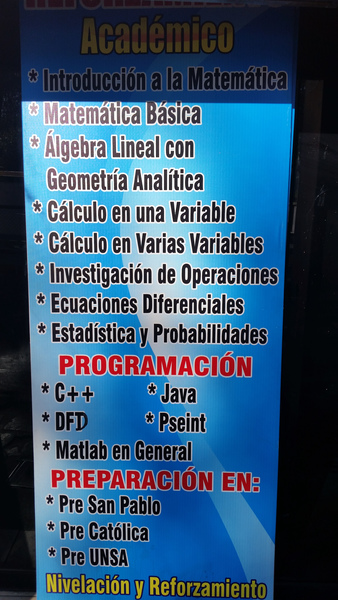
This day was the only day I didn’t see the school overrun with students. It was busy on Saturday and late into the evening. Based on the stickers on the hallway floors, the school seems to be genuinely interested in preparing these young folks for success.

Our working group took a divide-and-conquer approach to the report. The half I was not in generated a mural of post-it notes and diagrams to help organize their thoughts. I’m much more of a top-down organizer, and when I later joined the efforts of this half of the group, I had a very difficult time understanding what I was doing. Learning how others operate is a major benefit of these working groups!

Monday
The conference proper began on Monday. Mehran Sahami from Stanford delivered a keynote about gender balance in our programs and classes, advocating that we consider it in a more nuanced way to make sure that it’s truly our efforts that are improving the imbalance. In the afternoon, each working group presented a short summary of their efforts. When it was my turn to present, I began with a definition of game to make sure we were all on the same page. I showed a slide with a sequence of working definitions:

One gentleman got a little worked up about the third definition. He questioned the fundamental premise of our research because we said “X is X.” This man could not tolerate a recursive definition told as a joke and labeled as an intermediate line of thought. Our intent was that the scope of game on the right-hand side referred to the popular concept of a game. Besides feeling abused by his objection, some sentences from Chesterton came to mind:
Imagination does not breed insanity. Exactly what does breed insanity is reason. Poets do not go mad; but chess-players do. Mathematicians go mad, and cashiers; but creative artists very seldom. I am not, as will be seen, in any sense attacking logic: I only say that this danger does lie in logic, not in imagination.
Later on, when a group on gender equity presented their summary, this same man questioned the premise that we should strive for gender “equality.” At this point, he disqualified himself from being taken seriously.
Tuesday
A regular tradition of ITiCSE are builtin excursions to see the surrounding area. (We pay for these personally, not out of state funds!) I took a walking tour through the city. A major stop on this tour was a visit to a museum where we saw in person the Ice Maiden Juanita, a mummified Incan girl who had been clobbered on the head as a sacrifice atop a mountain. This experience was grim. In many ways, the tour celebrated the rich history of the area, but this sick twist of child sacrifice brought in a really big rain cloud to ruin that celebration. I missed my family.
Then we went to the Plaza de Armas and I saw a young girl feeding the pigeons. I took comfort in the fact that she wouldn’t be sacrificed.
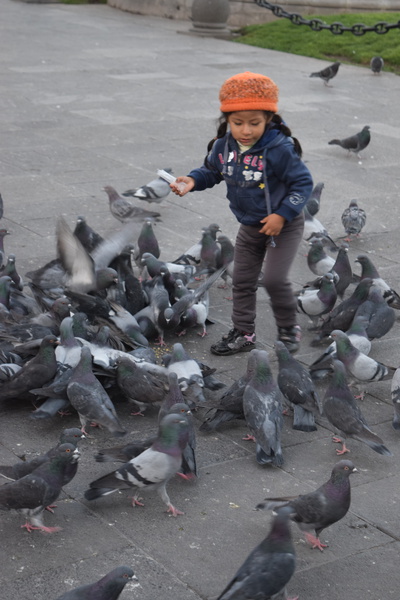
In the evening the conference banquet was held in a monastery. The tour beforehand shared about the tradition of sending second daughters there to be nuns, of the weekly self-flagellation exercises, of the nuns’ separation from the outside world, and of the reform that changed the way women enter the monastery in the modern day. The tour guide shared of one woman, a third child, who very much wanted to be a nun instead of marrying the man whom her parents had arranged her to marry. The parents had already sent her older brother to be a priest and would not pay this daughter’s way. So, she ran off and joined the monastery without her family’s financial support. Her priest-brother supported her instead, but she was given smaller quarters than the other nuns. She slept on a sheet of nails.

One of my favorite parts of the tour was that it took place at night. I’d be walking through a passage and look up, only to see stars instead of a ceiling. This kind of open-air building doesn’t happen in humid and buggy Wisconsin.
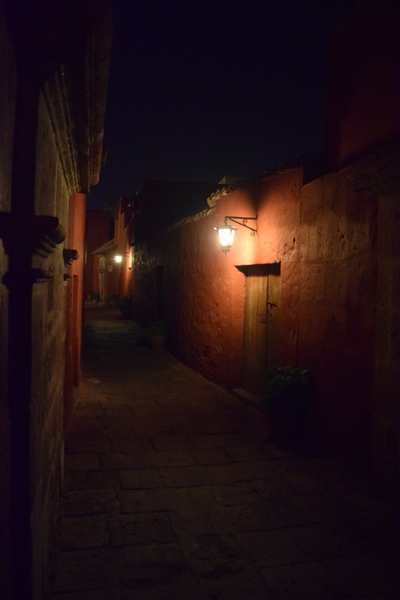
Wednesday
After the conference ended, I went to the market with some fellow group members. The exposed meat and dairy products were overpowering. We could not understand how a string of 20 vendors all selling the same things could sustain themselves.

The economy of Peru is centered on two things: taxis and tourism. The streets are filled with more taxis than personal cars, and each block has several shops selling Alpaca products. The fur of these Andean camels is very soft. I got my wife a sweater and my children some stuffed animal guinea pigs, all made of Alpaca fur.
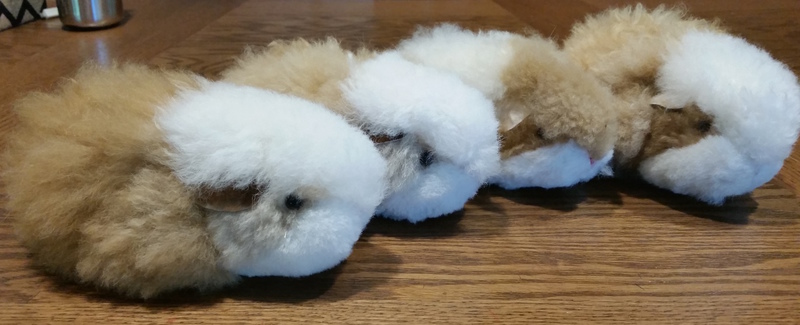
Thursday
I did not return home right away. Many of us conference-goers took some personal days to visit other parts of the country. Like Cuzco.
By this point in the trip, I was ready to swear off meat. But even my beautiful Tunupa salad came with chicken.

And I knew I’d probably not have another chance to try guinea pig.
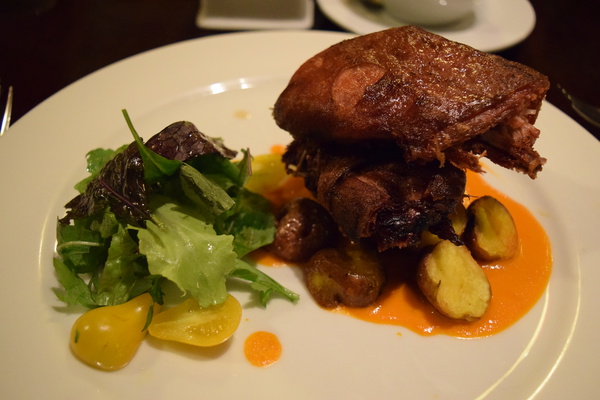
We took a tour of the town. A major theme of this tour was this strange symbiosis between Incan and Spanish culture and religion, all influenced by geography. A rendition of the Last Supper showed Jesus at a table with a guinea pig on a platter. Allegedly, it was not Judas in the picture, but Francisco Pizarro. Most Incan ruins had been razed when the Spanish landed, only to be restored when an earthquake toppled the churches that had been built atop them. Our tour guides talked about how they got the same feeling in an Incan temple as they did in church on Sunday. Vendors sold Spaniards vs. Incas chess sets.
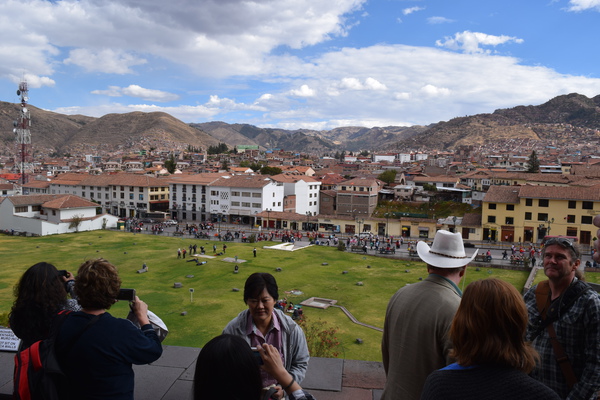

One of our stops was at a ruins named “Full Falcon” in Qechua after the Spanish-Incan battle that had killed many there. The Spaniards did not believe the Incans could have built the structures they did with such tight-fitting and large rocks, and believed demonic forces must have played a hand.
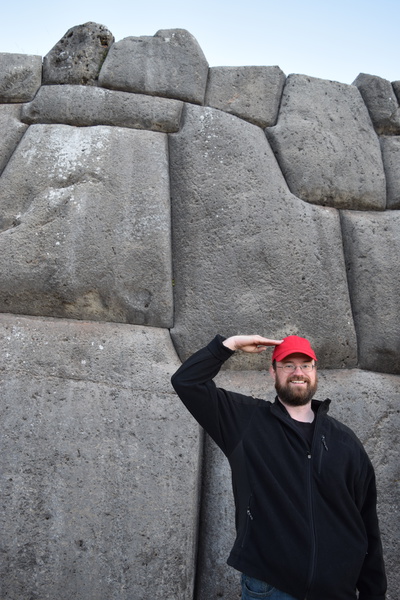
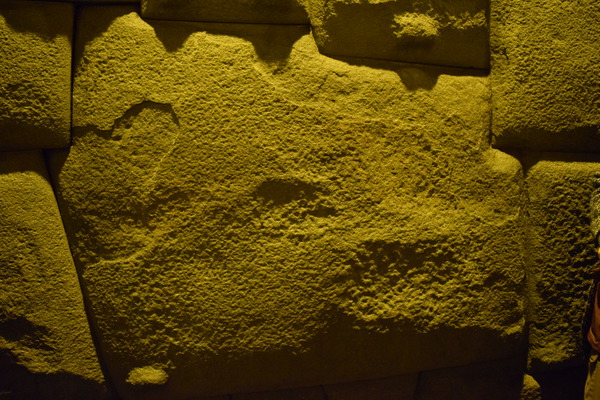
Friday
The next day I took a train to Machu Picchu. I sat with some folks from Illinois. John had run a bed and breakfast in Maine for 20 years. It was called Moon over Maine and initially had nine rooms, each themed around a planet. The Pluto room was small, and John had long wanted to knock down the wall between it and Neptune. When Pluto was declassified, he did exactly this. He shared many Uranus jokes, which he said never got old.

Machu Picchu was filled to the brim with tourists. I was one of them, so I couldn’t grumble too much. The bathrooms normally cost 1 sol (about 30 cents), but they were free when we visited because the water wasn’t working. The site was beautifully inaccessible, surrounded by mountains. It was marked by attentive craft, with windows carefully aligned to solstice light, neighboring mountain peaks, and mathematical triplets.


Our guide Fernando was wonderfully animated. He drew diagrams in the dirt with his finger, which is the mark of an excellent teacher. He had three pet dogs: Tony, Burro, and another whose name I can’t remember. He waited patiently for Wilma, who at 78 years old, had some trouble on the many steps. Still, she made it through to the end.
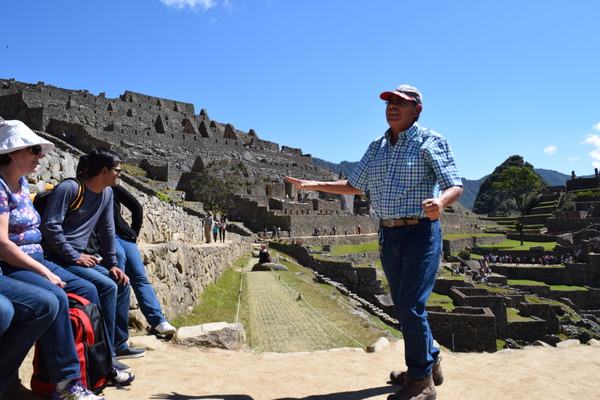
Fernando said that Germans, Dutch, and Kiwis were the fastest hikers, and that North Americans made up 60% of the visitors.
All week long I’d been carrying around a bag of roasted almonds that I’d grown sick of. While waiting for the train back to Cuzco, I befriended some pigeons by sharing them. The little girl in Arequipa had emboldened me.
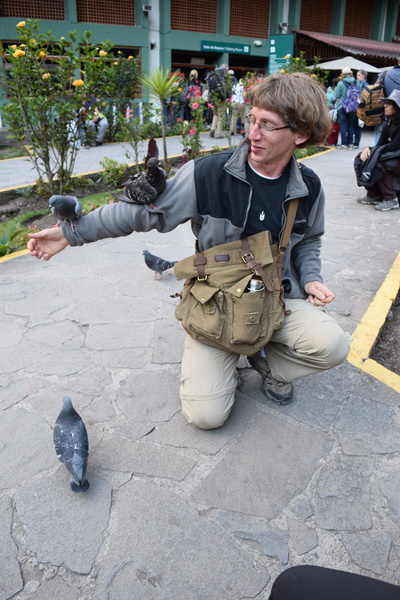
Saturday
My flight left late on Saturday, so I hung out at the public library in Cuzco and got some work done. I could not find books in this library, but they did have tables for working.
I found some street beggars to whom I gave the last of my Peruvian money, and these folks helped me recognize the privilege I so enjoy in North America, where I grew up with medicine and public services.
In the airport, Anthony from Canada helped me playtest a game I’d been working on. The volcanic rock sculpture of Arequipa that I had been given as a gift set off some alarms in security. So much for trying to save time by not checking any bags!
Sunday
Back in the US, I was greeted with the airport televisions reporting on Donald Trump and the Republican National Convention. Ahh, how nice it had been to turn this off for a while. After a shuttle ride from Minneapolis to Eau Claire, I was finally back home in the arms of my wife and children.